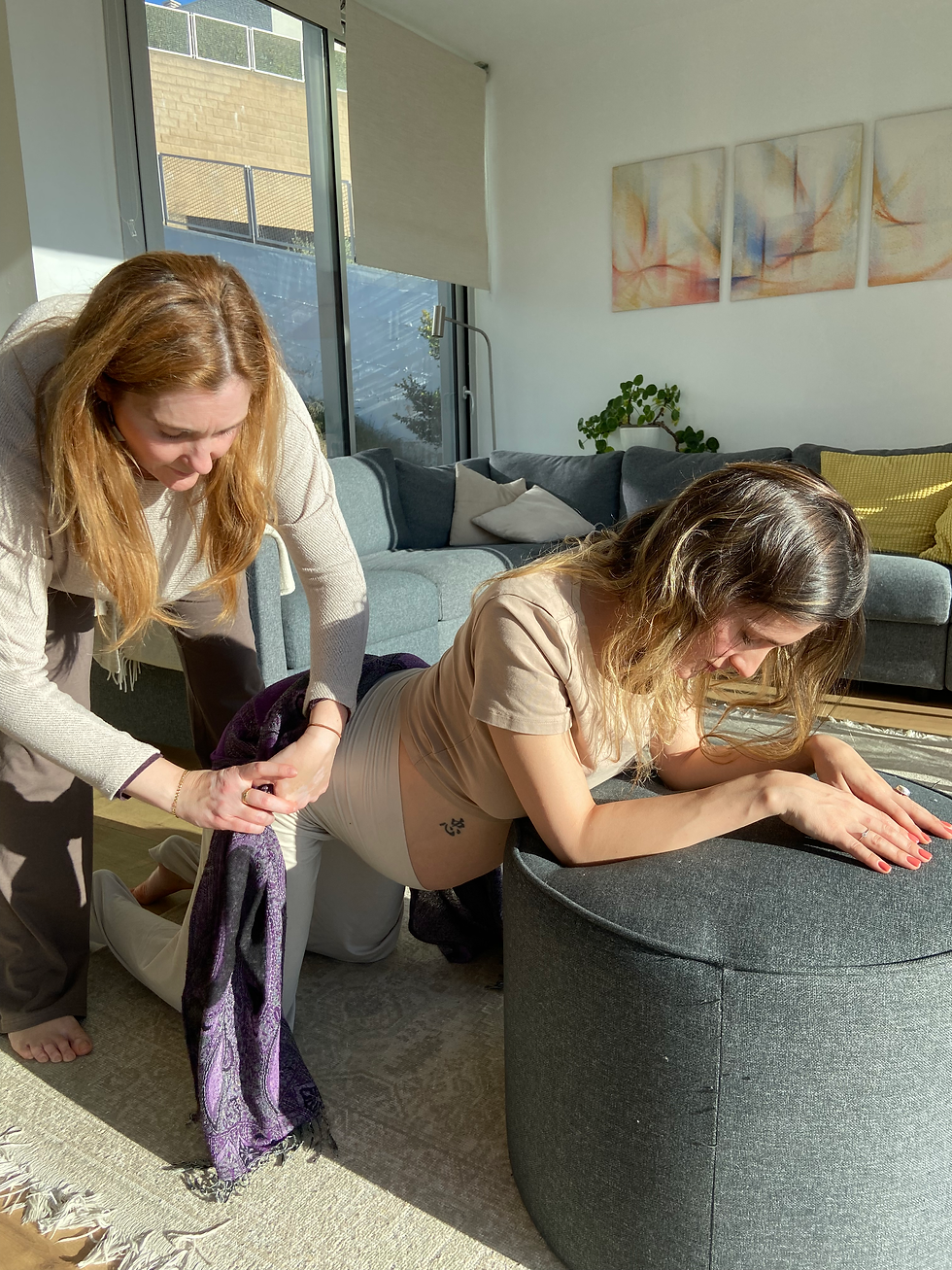Pre-Labour Contractions - Understanding the Signs Before Labour Begins
- annarochdeus
- Sep 25, 2025
- 6 min read

Becoming a parent is one of life’s most beautiful experiences, but it also comes with its fair share of questions, worries, and uncertainties. One of the most common questions I hear from couples, especially first-time parents here in Barcelona, is:
“How will I know when it’s time to go to the hospital?”
It’s completely natural to feel unsure. Pregnancy is full of changes, and the days leading up to labour can feel like a mystery. One of the things that often causes anxiety is understanding contractions, the ones that signal that labour is near, and the ones that are just your body practising and preparing. In this post, I want to guide you through what pre-labour contractions feel like, how to tell them apart from true labour contractions, and how you might approach hospital timing here in Barcelona.
What Are Pre-Labour Contractions?
Pre-labour contractions, sometimes called Braxton Hicks contractions, are your body’s way of practising for the big day. You might hear them referred to as “practice contractions,” and that’s a really good description, they are essentially your uterus gently preparing for the work ahead.
For many women, these contractions can start weeks before labour actually begins, sometimes sporadically throughout pregnancy. They often become more noticeable as you approach your due date. Some women barely notice them, while others find them a little uncomfortable.
So, what do they feel like? Usually:
They are irregular and unpredictable.
They don’t get stronger over time.
They last less than 30–40 seconds.
They may be uncomfortable or mildly painful, but rarely are they intense.
Sometimes they can even feel quite strong, enough that you notice them when you move or change position, but they usually ease off if you rest, drink some water, or change posture. This is one of the key differences between pre-labour and true labour contractions, they don’t build consistently.

Example: I once worked with a couple in Barcelona, Sara and Tom. Sara had been feeling strong, regular contractions for a few hours one evening. She was nervous and thought she was in labour. After a warm bath and a short walk around their apartment, the contractions slowed and eventually stopped. It was a classic example of pre-labour, showing them that not every strong contraction means labour has begun.
Pre-Labour vs. True Labour – The Key Differences
It’s easy to feel confused because pre-labour contractions can sometimes feel strong and even fairly regular. That’s why it’s important to know the signs that labour is actually beginning. Here’s a simple way to compare:
Feature | Pre-Labour Contractions | True Labour Contractions |
Frequency | Irregular, unpredictable | Regular, roughly every 2–3 minutes |
Duration | Short, 20–30 seconds | Around 1 minute |
Intensity | Uncomfortable, not overwhelming | Strong, can make talking difficult |
Pattern | Often stops with rest or hydration | Continues and builds despite rest |
Effect on Cervix | Minimal or none | Causes dilation and effacement |
Consistency | May come and go | Persistent, steady progression |
Understanding these differences is empowering. It helps you notice the subtle signals your body is sending and reduces unnecessary stress about “false alarms.”
Example: Maria and David, first-time parents in Barcelona, were preparing for their baby. Maria felt tight, crampy contractions every few minutes for most of a day. She worried that she might be in active labour, but after a gentle walk and some hydration, the contractions eased. Learning to differentiate between pre-labour and active labour helped them feel calm and confident.
Recognising the Signs of Active Labour
Active labour is the stage when your body is truly getting ready to meet your baby. Contractions become more predictable, stronger, and longer.
Here’s what to look for:
Contractions every 2–3 minutes.
Each contraction lasting around 1 minute.
The intensity is strong, you may notice it’s difficult to speak through a contraction.
This pattern continues consistently for 30 minutes or longer.
Sometimes, contractions can feel intense and regular but then slow down or stop. This is normal, and it can happen even in the early stages of labour. The key is consistency, if contractions keep building and remain strong, you are likely entering active labour.

Example: When Emma went into labour with her second baby, she had regular contractions for over an hour that felt so strong she couldn’t talk through them. Her partner and I stayed calm, timing them carefully. They decided to remain at home for as long as Emma felt comfortable, with me supporting them, before heading to their hospital in Barcelona. This allowed her to progress through part of dilation at home and enter the hospital feeling more confident and in control.
When to Go to Hospital
Knowing when to head to the hospital is one of the biggest worries for couples. In Barcelona, families often have choices between hospitals close by, and some with my doula support, choose to spend more time at home during early labour.
A few practical points:
Active labour: 2–3 minutes apart, 1 minute long, consistently for 30–60 minutes.
Talk test: If it’s difficult to speak during contractions, it’s a sign they are strong enough to be considered active labour.
Individual variation: Every labour is unique. Some women progress quickly, while others take longer. Trust your body and instincts.
Extra considerations: If your waters break, there is bleeding, or you notice a significant decrease in your baby’s movements, go to the hospital.
Supporting Your Partner During Pre-Labour
For partners, the pre-labour period can feel uncertain too. Here are some ways to help:
Encourage hydration and rest.
Offer comfort measures: massage, warmth, gentle touch.
Keep track of contractions together but remember, if they are mild, there’s no need to obsessively time them. Only time contractions when they become strong and close together.
Provide emotional reassurance: gentle words, patience, and calm presence go a long way.
Example: Ana and Mark stayed calm and focused during pre-labour, offering Ana massages and encouraging her to rest. Ana said his calm presence made her feel supported and safe, which helped her enjoy the early part of labour without anxiety.
Gentle Tips for Managing Pre-Labour at Home

Pre-labour can be long and sometimes exhausting, but there are ways to make it more comfortable:
Breathing and mindfulness: slow, deep breaths help you stay calm and present.
Movement: gentle stretching, walking, or rocking can help ease discomfort between contractions. When a contraction comes, try to relax and stay still, allowing your muscles to soften and your pelvic area to release tension.
Relaxation techniques: a warm shower, dim lighting, and calming music can help you feel more at ease.
Mental preparation: seeing these contractions as part of your body’s preparation, and accepting and surrendering to your body’s physiology during labour, can help you feel more at ease.
Remember, this time is a bridge between pregnancy and labour, it’s your body quietly getting ready for one of life’s most important experiences.
Example: Sofia spent her pre-labour evening practising deep breathing, taking warm showers, and walking around her apartment. She told me later that these small practices made the transition into active labour feel more natural and calming.
The Emotional Side - From Uncertainty to Confidence
It’s normal for couples to feel anxious during this stage. Pre-labour can be unpredictable, and it’s easy to overthink every twinge or tightening. But knowledge brings calm.
Understand that every labour is different.
Pre-labour is a natural and normal process, not something to fear.
Trust that your body knows what it’s doing, you’re not alone.
Embrace the process with acceptance, rather than trying to control every detail.
Example: Chloe felt overwhelmed by the irregular contractions she was having. Once we discussed what to look for and practised noticing intensity rather than timing everything, she felt reassured and even excited that her body was preparing for birth.
Final Reassurance & Empowerment
Trust your instincts, trust your body, and trust that you will know when the time is right. Pre-labour is your body’s way of saying:
“We’re ready, let’s prepare.”

If you’re ever unsure, remember that support is always available, from your doula, midwife, or healthcare provider. There is no wrong question and no unnecessary call for guidance. You are learning and navigating one of life’s most extraordinary experiences.
Take a deep breath, enjoy these final moments before your baby arrives, and embrace the journey with confidence. This is the start of a beautiful chapter in your lives, and every contraction, every wave of discomfort, is bringing you closer to meeting your baby.
You’ve got this. Your body is ready, and so are you.
If you would like support during this time, or want guidance tailored to your birth experience here in Barcelona, feel free to book a free consultation call with me, I would be honoured to accompany you on this journey.
With love,
Anna, Founder of MyMamaDreams
Doula | Lactation Consultant | Gentle Sleep Coach
#BirthPreparation #BabyPreparation #BirthAndBaby #PositiveBirth #EmpoweredBirth #ExpatFamilies #ExpatParents #BarcelonaMamas #ParentingInSpain #ExpatLifeBarcelona #DoulaSupport #LactationConsultant #GentleSleepCoach #MyMamaDreams #ParenthoodWithConfidence #ConfidentMamas #EmpoweredParenthood #CalmBirth #GentleParenting #MotherhoodJourney



